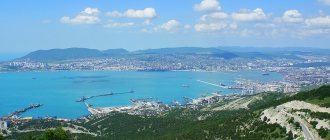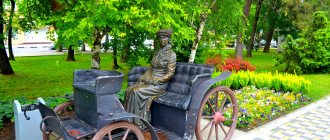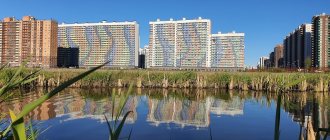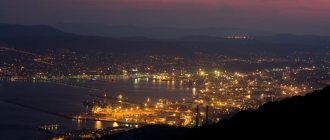History of the city of Novorossiysk
similar to the history of many of today’s settlements in the Black Sea region, from Anapa to Sochi and Adler. Almost all of these cities and towns originate from Russian fortresses created here from the late 20s to the late 30s of the 19th century. These outposts were created to strengthen the influence of the Russian Empire in the Black Sea region and repel the opposition of the local Adyghe-Circassian population.
The annexation of the Black Sea coast of the Krasnodar Territory to Russia in the first half of the 19th century was accompanied by military actions of several Russian-Turkish wars and the Caucasian War. During these events, military outposts of the Russian army were created on the coast. The territory of today's Novorossiysk was inhabited back in Paleolithic times. The first real city here was a settlement of Greek colonists.
The city of maritime glory Novorossiysk has a very interesting and complex history
Greek Colony of Bata
Based on ancient written sources and mentions of the first Russian settlers of Novorossiysk about the ruins of a certain ancient Greek city, scientists believe that in the 6th century BC. on the site of today's Novorossiysk there was the Greek city of Bata.
Once upon a time, on the site of Novorossiysk there was the Greek city-state of Bata
Archaeological evidence of its existence was found in later times during construction work during the Soviet period at the bottom of Tsemes Bay, etc.
Bata, like all Greek metropolises of that period, was a trading city-colony. The local colonists had well-developed agriculture, fishing, and various crafts. Trade was also going well. Mainly bread and fishery products were exported, while wines, olive oil, and ceramics were imported.
Bata was one of the easternmost Greek colonies
In the 5th century BC. Almost all the Greek city-states of the Black Sea region were united into a single Bosporan kingdom, which later became part of the Roman Empire. Bata found itself on the very southeastern border of this state entity.
The remains of this semi-mythical city have not been found and there is no direct evidence of its location. But it is believed that it was located on the site of the Seaport, whose structures concreted the possible remains of a Greek settlement. But the fact that there was an ancient Greek trading pier in Tsemes Bay is clear from the ancient anchors and amphorae found in the bay.
All ancient artifacts can be seen today in the Novorossiysk Museum
Fortified fortresses were built around Bath, which were supposed to secure the approaches to ancient Gorgippia (today's Anapa). One of these fortresses was located on the site of the village of Myskhako. All these Greek settlements were subsequently destroyed by the nomadic tribes of the Alans, Goths and Huns in the 2nd and 3rd centuries. Since then, the settlement of this region began by the ancestors of the Adyghe and Circassian peoples, who gave the name to the local river - Tsemez (translated as “swampy forest”). And the river, in turn, gave the name to the bay itself - Tsemezskaya.
Fact 9. The most unusual museum in the city
There are so many amazing museums created in different countries: shoes, toilets, dance, and carriages. But in Novorossiysk they offer a look at the most unusual museum in the city - the Cement Museum.
Its exhibition will appeal to those who love unique and atmospheric places. By visiting the cement industry museum, you will learn a lot of interesting things about the history of cement, concrete and brick. Boring? No, reviews from visitors are usually full of delight.
We will be glad if our article helped you learn something new about this wonderful maritime city. We wish you bright impressions and a pleasant trip!
Sudzhuk-Kale Fortress
The convenient location of Tsemezskaya, and later Tsemesskaya Bay, was also noted by Genoese merchants
, who
in the 13th century
, called Batario. The site of this trading fortified city is today occupied by October Square. The Batario fortress existed as a Genoese residence until the 15th century, until the influence of the strengthened Ottoman Empire increased in the Black Sea region. The Genoese fortifications themselves existed for a long time. Their remains suffered significant damage during the battles of the Great Patriotic War and were finally dismantled at the end of the 50s of the 20th century. Fragments of the former fortress can be seen today in the Novorossiysk Historical Museum.
Novorossiysk Bay attracted Greeks, Genoese, and Turks
Having driven out the Genoese, the Turks organized a small slave market here, but due to problems with the local climate (ice forest in winter) they did not use this coast for permanent residence for a long time. Moreover, the Crimean Khan, who was a vassal of the Ottoman Empire, was responsible for the administrative order here.
However, at the beginning of the 18th century
Problems began with the Crimean Khanate, subordinate to the empire, which could no longer maintain control over this territory and restrain attacks by mountain tribes on local settlements. In this regard, and at the personal request of the Crimean Khan, the Turks decided to build their own fortress in Tsemes Bay. Although at first Gelendzhik was chosen as the location of the fortress, then it was decided to build it on the cape of Tsemes Bay, from where the fairway of Gelendzhik Bay was clearly visible.
The site of the former Turkish fortress can still be visited today
The fortress, called Sudzhuk-Kale, was built by 1722
. Its direct builders were Tatar residents, but the architect was a representative of Turkey. Construction was carried out under the protection of the Turkish fleet.
The square brick fortress was not very large. Its perimeter was a little over 800 meters. At the corners there were bastions in the form of pentagonal towers with nine guns. The fortress walls, 4 meters wide, were surrounded by 6-meter ditches and oxen, behind which there was an esplanade (free space). The main gate on the northeast side led to the seaport buildings. On the opposite side was the Gate of Constantinople.
The Sudzhuk-Kale fortress was at one time a small quadrangular fortification
Today, curious tourists can see a partially preserved marble slab of the main gate in the city Novorossiysk Museum. Janissaries and Tatars lived inside the fortress along with their families.
For some time, the Turkish fortress Sudzhuk-Kale was the center of an administrative region located between the left bank of the Kuban River and the Black Sea coast. On the territory of the fortress there were about two hundred chaotically located houses, and the population was approximately four hundred people. In general, at the first stage of its existence, outwardly it was a small Tatar village headed by a bey who collected taxes from the surrounding population.
The remains of the slab from the main gate of Sudzhuk-Kale have miraculously survived to this day
The main type of tax in Sudzhuk-Kale were slaves, who were prisoners captured by the mountaineers and foreigners who had fallen out of favor. Sudzhuk-Kale, together with Gelendzhik, supplied up to 12,000 slaves to Constantinople annually, including beautiful mountain girls destined for the harems of noble Turks.
During the Russian-Turkish War of 1768-1774
near the fortress, which became a combat bridgehead for the Turkish naval forces, battles took place between them and the Russian Don squadron. After this war, the Crimean Khanate became independent and was annexed to Russia. Sujuk-Kale has since become a Turkish fortress and one of the strongholds of the struggle for the return of Crimea to the rule of the Ottoman Empire. The Turkish fleet began to be based here, and preparations were made for landing troops on Crimean territory. All these actions ran counter to the concluded peace treaty of Kuchuk-Kainardzhi.
At the end of the 18th century, the Turkish fleet was constantly located in the Tsemes Bay area
Under the terms of the Kuchuk-Kainardzhi Treaty, Turkey was supposed to withdraw its troops from Sujuk-Kale, leaving the fortress to the Tatar population. But the forced displacement of Tatar families from the fortress began in order to transform it into purely Turkish territory. In addition, emphasis was placed on the fact that numerous mountain peoples were under the protection of the Ottoman Empire, whose support was bought with bribes.
As a result, only about three dozen Janissaries remained in the fortress, who were unable to maintain the viability of Sudzhuk-Kale, which led to its decline. Sensing the weakness of the small garrison, the mountain tribes became more active. They captured Turkish soldiers and sold them into slavery.
The Turkish fortress Sujuk-Kale was constantly attacked by mountaineers
1778 incident is particularly well known.
, when a large 4,000-strong Turkish squadron, led by the fleet commander, arrived in Sujuk-Kale. On the very first night, two hundred Turkish soldiers were kidnapped by the mountaineers and then returned for a huge ransom. Tatar villages also suffered from attacks by mountaineers.
During the period of Turkish rule, Sujuk-Kale played the role of a port town, near which there were dozens of ships in the roadstead. The role of the fortress as a Turkish stronghold increased, and it was to become a new purely Turkish administrative center. But the activated mountain tribes prevented this. They stormed the fortress several times and burned objects located outside it, including food stores. In the end, a long blockade of the fortress began, as a result of which almost all of its defenders died of hunger.
It’s hard to imagine that such a busy life once took place in this place.
After the ransom incident, the Turkish authorities changed tactics and tried to turn the mountaineers into their allies. On the one hand, Turkish representatives began to marry the daughters of mountain leaders, on the other hand, they began to actively convert the mountain people to Islam. During this period, the Turks began to strengthen Sudzhuk-Kale and build new fortresses, including Anapa. It was planned to use warlike highlanders to defend these fortresses, but they did not want to settle in the enclosed areas of the fortresses. Then they were settled by representatives of Asia Minor.
In 1784
Sujuk-Kale was rebuilt both outside and inside. It had new fortifications, a pasha's palace and a mosque, arsenal buildings and barracks. After the completion of the construction of the Anapa fortress, the head of Sujuk-Kale Ferah Ali Pasha moved there, but continued to manage this fortress.
The leadership of Sudzhuk-Kale in the 80s of the 18th century was carried out from the Anapa fortress
Subsequent commandants were more concerned with the slave trade than with strengthening the garrisons. This is probably the only reason why in 1791 the Russian troops of General Gudovich were able to take Anapa and almost completely destroy all the buildings of the Sudzhuk-Kale fortress.
However, on the basis of the next Yassy Peace Treaty, both Anapa and Sudzhuk-Kale again ceded to Turkey and were restored. During the next Russian-Turkish War in 1810, Sudzhuk-Kale was taken again by Russian troops and began to modernize, but the new peace treaty of 1812 forced the Russians to leave these places. When leaving, the Russians blew up the fortifications. The Turks did not begin to restore the fortress, and a local market was organized on this site, where everything was sold, including slaves.
The Sudzhuk-Kale fortress existed on world maps until the end of the 18th century
Another peaceful Treaty of Adrianople in 1829
after the end of the Russian-Turkish War of 1828-1829. secured the lands of Tsemes Bay to Russia. But the Russian landing occurred somewhat later - in September 1838, when a powerful squadron was formed led by generals N. Raevsky and M. Lazarev for the systematic development of the Black Sea region. The landing of an almost 6,000-strong detachment took place on September 12 near the ruins of Sudzhuk-Kale, since then this day has been considered the birthday of Novorossiysk and the beginning of its new Russian history.
Novorossiysk within Russia
First birth of Novorossiysk
So, in 1829
The Black Sea region officially became Russian territory. Since 1831, Russian warships cruised along the coast. Their task was to prevent smuggling trade between the highlanders and the Turks. And a little later, fortified outposts began to be created here. The first fortification of Tsemes Bay on Cape Doob was Kabardinka, which then, back in July 1836, was called the Alexandria fortification.
Count M.S. Vorontsov advocated the need to create a fortification in Tsemes Bay
The governor of this region, M.S. Vorontsov, wrote to the emperor about the need for a more powerful fortification of this bay. In the fall of 1937, Nicholas the First himself visited the new Russian shores, examining the already existing fortifications in the form of Gelendzhik and Anapa. At the same time, a decision was made on a military naval expedition to more remote areas of the Krasnodar coast with the aim of landing troops there and organizing new fortifications. This is how the now famous resorts Adler, Sochi, Lazarevskoye and many others appeared.
Nicholas the First came with his heir to get acquainted with the new Russian shores
The appearance of such a fortified point and port as Novorossiysk was the initiative and merit of General N. Raevsky. It was he who was able to prove the need to create a port city for Russian ships in Tsemes Bay. And already in January of the following year after the landing - in 1839
year, a new Russian settlement received the status of a city, which was called Novorossiysk. Within the 4-kilometer perimeter of the new city there were forts, blockhouses, ditches with drawbridges, and earthen ramparts. The civilian population settled in the lands outside the fortifications.
N. Raevsky is rightfully considered one of the main founders of Novorossiysk
At the end of the 40s, the Admiralty building grew up on the territory of the port fortress, built in the northwestern corner of the bay. The construction of this structure was approached very responsibly. Its project was developed by the Commander-in-Chief of the Black Sea Fleet M.P. Lazarev
, insisting that the structure be built of brick and sheathed with iron. Stone, brick and lime were brought from Kerch, and timber, iron and nails from Kherson. The construction of the Admiralty took 12 long years.
Today, on the site of the former Admiralty, there is the famous House with a Spire
The Admiralty, consisting of three one-story buildings connected to each other, housed an arsenal, food warehouses, a forge, premises for ship repairs, etc. Garrison employees were also involved in agriculture.
As already mentioned, General N. Raevsky
, considered the founder of Novorossiysk.
And after his resignation, Admiral L. Serebryakov
turned the city from a military outpost into a large Black Sea port and a developed city with a school, hospital, library, etc. Today, the city Embankment bears the name of Serebryakov, where tourists can see the Monument to the founders of the city, which includes this famous urban planner of Novorossiysk.
The townspeople immortalized the images of the city founders in the Monument on the Embankment
By the beginning of the Crimean War, Novorossiysk was a fairly well-equipped naval base. However, it did not have sufficient protection from the sea. Nevertheless, the defenders of Novorossiysk withstood the first battles with the enemy fleet with honor. But, in accordance with the order received, Novorossiysk was abandoned, as was Anapa. Before leaving, all fortifications were destroyed. And the main military forces were redeployed to guard the Kerch Strait. So the city of Novorossiysk ceased to exist.
The second birth of Novorossiysk
After the end of the Crimean War, Russian troops appeared on the territory of Novorossiysk only in April 1858. A temporary Konstantinovsky fortification was created, under the protection of which the restoration of the city began. The population returned to abandoned houses. The first hundred Cossack families created the Novorossiysk village here.
By the autumn of 1866, Novorossiysk again received the status of a port city and officially became the center of the Black Sea District. At that time, the city had a little more than 400 inhabitants. And since 1896, the city has already become the center of an entire province. The development of urban planning during this period was formed around the restored Admiralty. So in the 70s, the city center was formed from Tsemesskaya and Raevskaya streets, Agentsky Lane, etc.
The name of N. Raevsky before the revolution was immortalized in the name of the street and boulevard
In the second half of the 19th century (1888), the railway came to Novorossiysk, and the city began to develop at a very fast pace. The city developed even more after the mineral needed for cement production, marl, was discovered in the nearby mountains. Cement began to be produced in the city in 1882 at the first cement plant. Before the revolution, there were already ten cement factories operating in Novorossiysk. The largest elevator in Europe and an oil refinery were located in Novorossiysk.
There were more than enough jobs in the city. It was possible to get a job in a railway workshop, at any of the local factories, including a soap factory, a tannery, a sausage factory or a brewery. Mills also worked here and there was a fishing industry.
The largest elevator in Europe operated in Novorossiysk
Novorossiysk was built up and became more beautiful year after year. Tenement houses and mansions, temples and hotels appeared here. Of the most famous, miraculously preserved pre-revolutionary buildings of Novorossiysk, the House of the Merchant S. Obradovich
(1869), House of the famous tobacco manufacturer
A. Jukelis
(1913),
Lutheran Church
(1908) and
City House
(1908). Before the revolution, the Obradovic House housed the Azov-Don Commercial Bank, one of the largest in Russia.
By the end of the 19th century, the population grew to three thousand inhabitants. The Novorossiysk port was one of the largest in the country; it received up to 300 ships annually. The city began to welcome numerous vacationers, for whom bathing facilities were organized, beaches were improved, hotels and restaurants were built.
At the beginning of the 20th century, the Azov-Don Bank was located in the House of the merchant S. Obradovic
In 1904, a small cemetery church of the Assumption of the Blessed Virgin Mary appeared in Novorossiysk, which eventually became the Main Cathedral of the city. But the fate of the Admiralty developed this way. After the war, it was handed over to the city, which housed it first as a men's school, then as warehouses. Subsequently, due to disagreements between the city and the military department, the building was left unattended for years and began to collapse.
At the end of the 19th century, all the Admiralty buildings were dismantled, and the land was transferred to the Novorossiysk port, which leased the land to a circus troupe. The circus existed here until the fall of 1912, when its buildings were destroyed by fire. In 1913, it was planned to build a monument on this site for the 300th anniversary of the House of Romanov. Then it was planned to build a railway station pavilion, and even its design was developed and the estimate was approved. But the First World War began.
Pre-revolutionary Novorossiysk formed as a large industrial city
After the revolution, residential buildings appeared on the site of the former Admiralty, which suffered greatly during the next war - the Great Patriotic War. After the war, a House with a spire and nearby Heroes' Square with a Memorial and Eternal Flame appeared here.
Criminal situation
No matter where in the world you go, to live or vacation, it is important to find out what the crime rate is in the city of your choice. Novorossiysk cannot be called prosperous in this regard.
This is one of the places in the Russian Federation where more crimes are committed than in the capital. Main problems:
- drug trafficking;
- arms trade;
- burglary;
- real estate.
The latter should be taken into account if you are going to buy a house, apartment or land. “Black” realtors operate on a par with normal licensed realtors.
You should check the availability of the necessary constituent documents and monitor the company's reputation.
The fight against crime has been quite successful in recent years. However, the city still cannot be considered prosperous.
Soviet development of Novorossiysk
Novorossiysk, as a fairly large and developed industrial city, took an active part in both Russian revolutions. During the revolution of 1905
The Novorossiysk Republic was created here, which existed for a very short time.
During the February Revolution of 1917, power in the city passed into the hands of the Provisional Government, which was liquidated at the end of November of the same year. And on December 1, 1917,
Soviet power was proclaimed in the city.
Many people gathered in the church square for revolutionary rallies
In connection with the outbreak of the Civil War and the offensive of the White Guard troops and interventionists, it was decided not to return the ships of the Sevastopol Fleet that arrived at the port of Novorossiysk in the summer of 1918, but to scuttle them in Tsemes Bay. About 20 ships and vehicles ended up at the bottom of the bay on June 18-19. Some are still there today.
In June 1918, about 20 ships of the Russian fleet were sunk near Novorossiysk
At the end of August 1918
Novorossiysk passed into the hands of the White Guard. From the Novorossiysk port, which in the spring of 1920 became the main evacuation base, mass emigration of participants in the “white” movement and civilians who did not want to live under the Soviets began. Episodes of such evacuation can be imagined from the films “Running” and “Two Comrades Served.” The “Exodus” Monument installed on the Embankment reminds of these historical events, which is like an illustration of the final fragment of the film “Two Comrades Served.”
In the spring of 1920, thousands of emigrants left Russia forever from the port of Novorossiysk
Nicholas II's sister Olga and her children, Grand Duchess Maria Pavlovna, politician Pyotr Struve, and the famous General Denikin also emigrated from Novorossiysk. On May 1, 1920, a May Day demonstration took place in the already “red” Novorossiysk.
After the establishment of peaceful life, Novorossiysk began to develop not as a resort, but as an industrial port city. Factories operated here, a port functioned, by the end of the 30s illiteracy was completely eliminated, and at the same time most of the ships sunk in 1918 were raised from the bottom of Tsemes Bay.
On the eve of the Second World War, dozens of industrial enterprises operated in Novorossiysk
Fact 2. “Bearded” disaster
The city's advantageous geographical position meant it would develop quickly. But the founders of the city lost sight of a very important circumstance that greatly overshadowed the rosy plans.
We are talking about bora, a strong wind that occurs when a cold stream of air overcomes an obstacle in its path and falls down with enormous force. From the city side, the bora looks like a giant beard crawling down from the mountains.
At the initial stages of the construction of the city and port, the destructive power of this natural phenomenon was greatly underestimated. But very soon the elements showed their character: for several days in a row, roars, whistles, icing, and hurricane winds tormented the city.
This phenomenon still causes trouble for local residents. Nevertheless, an interesting fact about Novorossiysk is that the bora is the calling card of the city.
Novorossiysk during the Great Patriotic War
The peaceful development of the city was interrupted by another war - the Great Patriotic War. Many townspeople went to the front. And the front line was inexorably approaching Novorossiysk itself, because the Germans were determined to capture such an important strategic city as Novorossiysk, which has a convenient port harbor and powerful cement factories. A new, German name was even invented for the city - Adolfstadt.
Novorossiysk had to stop the advance of the invaders to the east
Novorossiysk began to actively prepare for defense. More than two hundred defensive fire points and many anti-tank obstacles were organized. Volunteers joined the ranks of the people's militias, command posts were created to coordinate them, etc. But, despite the heroic resistance of the city, German troops nevertheless entered it on September 7, 1942
. A period of enemy occupation began, accompanied by robberies, executions and the establishment of a new order.
The orders of the German command in the occupied city were very eloquent
However, the Nazis failed to capture the entire city. The defenders of the city's defense were able to hold the line of defense in the area and the passage to Novorossiysk Bay was closed to the invaders. Taking into account the fact that the entrance to this bay was also controlled from Gelendzhik, not a single German ship ever entered there. You can read about the role of Gelendzhik in the defense of the front line in this region here.
At the beginning of February 1943
On a small bridgehead on the southern outskirts of the city, later called
Malaya Zemlya
, an amphibious assault under the command of Caesar Kunikov landed from front-line Gelendzhik. The landing party consisted of more than 270 people. They heroically held this small piece of land, part of which was located on the territory of Myskhako, for 225 days, until, as a result of the Novorossiysk-Taman operation, the city was completely liberated from the Nazi invaders.
The front line passed through Novorossiysk, which was never completely captured
Today you can get acquainted with the heroic everyday life of the defenders of Malaya Zemlya in the museum Memorial of the same name, which is located on the eastern side of Cape Myskhako.
Heavy and bloody battles for Novorossiysk, started from three directions, including Malaya Zemlya, lasted from September 9 to September 16, 1943. The enemy troops could not stand it and retreated. On September 16, Gord was finally liberated.
The heroism of the defenders of Novorossiysk was subsequently highly appreciated
The heroism of Novorossiysk, which held the line of defense for almost 400 days, was subsequently highly appreciated, and in 1966 the city was awarded the Order of the Great Patriotic War, 1st degree. In 1973, he was awarded the title of Hero City, and was also awarded the Order of Lenin and the Gold Star medal.
The Crimean War is a sad page of history
1853 is the date of the beginning of the Crimean War, which was very difficult for Russia. Our country was opposed by a powerful coalition of several European states. At the beginning of 1855, the enemy squadron approached the shores of Novorossiysk. The Russian fleet at that time was completely blocked in Sevastopol , while the coastal guns had a very short range. Therefore, the command made the only correct decision at that time: while the enemy was firing from afar with destructive fire along the coastline, all our guns were silent. When, confident of complete victory, the enemy troops approached closer to the shore, our guns hit them with all their might. Taken by surprise, the enemy ships chose to urgently retreat. This battle was won by us.
But, unfortunately, the war itself was lost; under the conditions of defeat, the Black Sea Fleet and fortifications on the coast were destroyed. The city was abandoned by the Russian garrison, as well as many local residents.
Novorossiysk modern
The battles of the Great Patriotic War caused enormous damage to Novorossiysk. The city was destroyed, many residents died. The restoration of Novorossiysk was greatly facilitated by the fact that the General Secretary of the ruling party of the Soviet Union, Leonid Brezhnev
during the war he participated in the defense of the city, namely, he was on Malaya Zemlya as a political instructor. Therefore, during the reign of Brezhnev, there was increased interest in Novorossiysk, and all kinds of assistance were provided to the city.
The monument to L. Brezhnev, installed in Novorossiysk, is one of the few in the country
Today's Novorossiysk is one of the largest ports in Russia. The country's naval base is located here. There is also a large transport interchange of railways and highways. Novorossiysk is the center of the municipal entity of the same name, which includes the city itself and all settlements of the former Novorossiysk region.
Most of the Novorossiysk Bay is occupied by the Russian Naval Base
The population of Novorossiysk is almost 276 thousand people, and this figure is increasing year by year. Mainly the Russian diaspora lives here, but there are representatives of the Armenian, Ukrainian, Tatar and other diasporas. The city has its own flag, coat of arms and even its own anthem, written by D. Shostakovich in 1960. This anthem can be heard in Heroes' Square
, where it is executed in accordance with the approved schedule.
Heroes Square is a memorial and memorable historical place of Novorossiysk
As already mentioned, Novorossiysk is not a resort city. It is developing as an industrial Russian city. Here, since the pre-revolutionary period, cement production has been developed at a high level, produced at five factories in the city. The production of construction, woodworking, food, steel and other industries has been established. Table and sparkling wines are produced in Novorossiysk.
Novorossiysk today is a large industrial and port city
The city has a well-developed infrastructure, there are many shops, both food and non-food. There are many catering establishments. The only very big problem in the city remains the water supply, which is not able to provide the city with water around the clock.
Novorossiysk has many cultural institutions - libraries, museums, theaters, cinemas, palaces of culture and park areas. There is even a Planetarium here. There is a beautiful embankment in Novorossiysk, on which there are many very interesting sculptural images.
One of the most popular monuments is “Sailor” - the wife of a sailor
There is something to see here for the inquisitive tourist. And even if you don’t come to Novorossiysk for the entire vacation period, it’s quite possible to find at least one day to get to know this interesting historical city.
It’s easy to get to Novorossiysk from Anapa, Gelendzhik, Kabardinka and other places
Author of the article: Kasatkina Tatyana
South Ozereyka
South Ozereyka is another favorite vacation spot for residents of Novorossiysk, which is still poorly developed by tourists from other regions.
The village is located twelve kilometers from the city and two from Shirokaya Balka. Unlike Shirokaya Balka, Yuzhnaya Ozereyka was not built on the seashore itself, but a little further away.
The village has a convenient, well-maintained two-kilometer pebble beach and several small wild beaches .
On the central beach there is a diving center, as well as rental of sun loungers, umbrellas, catamarans, boats, and attractions. There is a small private winemaking enterprise in South Ozereyka. Experts say that local wine is not inferior in quality to Myskhak wine, but is much cheaper. The village is also popular among sea fishing enthusiasts.
Not far from South Ozereyka, on the road to Abrau-Durso, the Rossiya Cultural and Tourist Complex was built with a riding school, where hippotherapy sessions are held for autistic children . Tourists from all over the coast come to watch the equestrian costume historical show "Rome".










